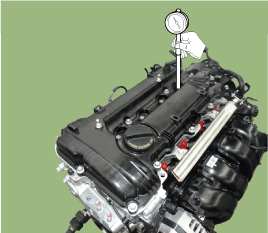| 4. |
Check cylinder compression pressure.
| (1) |
Insert a compression gauge into the spark plug hole. 
|
| (2) |
Fully open the throttle. |
| (3) |
While cranking the engine, measure the compression pressure.
| • |
Always use a fully charged battery to obtain engine speed of 200 rpm or more. |
|
|
| (4) |
Repeat steps (1) through (3) for each cylinder.
| • |
This measurement must be done in as short a time as possible. |
|
Compression pressure:
1,275 kPa (13.0 kgf/cm?, 185 psi)
Minimum pressure:
1,128 kPa (11.5 kgf/cm?, 164 psi)
Difference between each cylinder:
100 kPa (1.0 kgf/cm?, 15 psi) or less
|
|
| (5) |
If the cylinder compression in 1 or more cylinders is low,
pour a small amount of engine oil into the cylinder through the spark
plug hole and repeat steps (1) through (3) for cylinders with low
compression.
| A. |
If adding oil helps the compression, it is likely that the piston rings and/or cylinder bore are worn or damaged. |
| B. |
If pressure stays low, a valve may be sticking or seating is improper, or there may be leakage past the gasket. |
|
|
 Specifications
Specifications Troubleshooting
Troubleshooting


